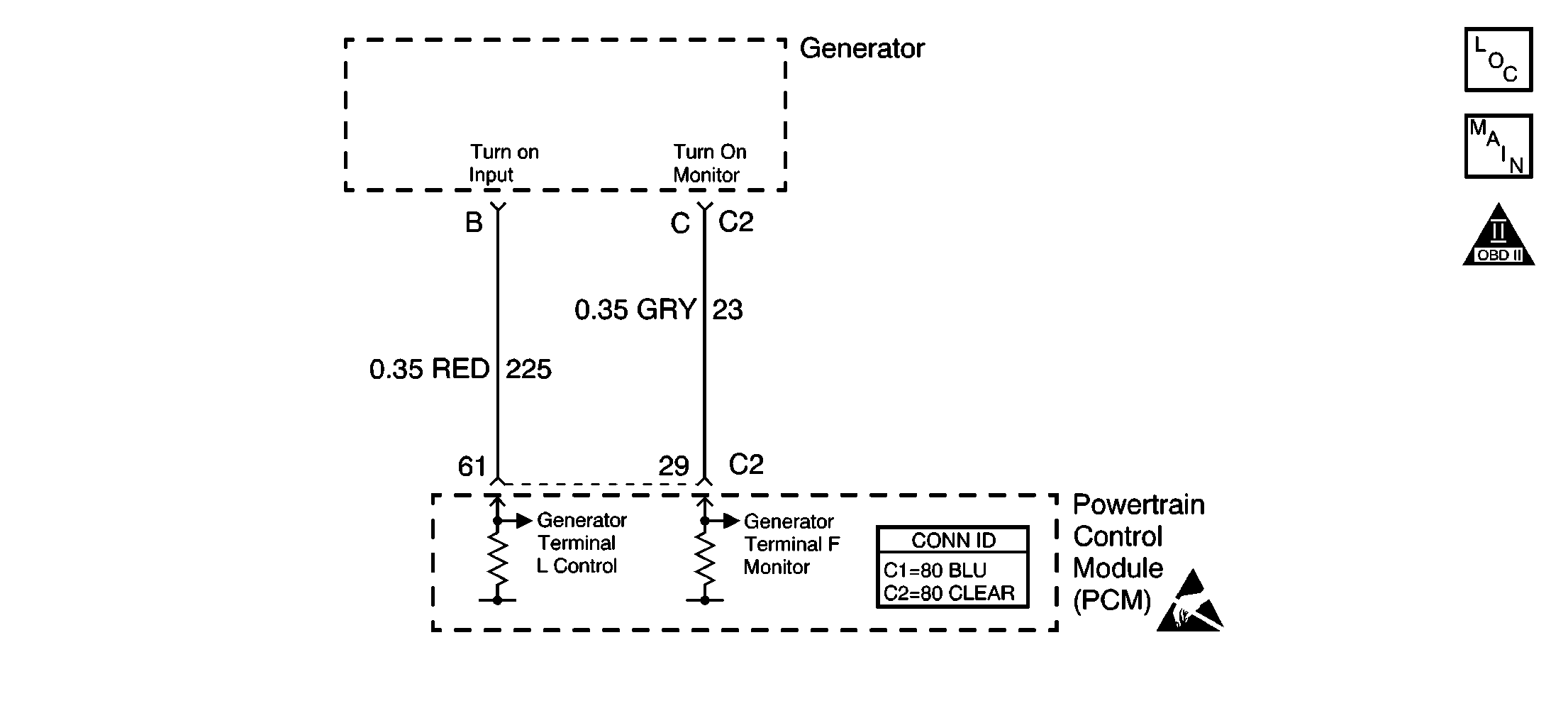
Circuit Description
The PCM output L terminal to the alternator determines when the alternator will be turned OFF. The output L terminal is on under all normal vehicle operating conditions except during low RPM conditions. The alternator is turned OFF during low RPM conditions in order to remove excess load from the engine.
The PCM input field F terminal from the alternator provides a 400 Hz pulse-width modulated (PWM) signal to the PCM. The duty cycle of the F terminal mimics the duty cycle of the field coils in the alternator. Thus, the F terminal duty cycle indicates the relative electrical load on the alternator.
The alternator tell-tale lamp will illuminate any time the ignition is on and the engine is not running. The lamp will go out after the engine is running and the alternator is putting out the desired amperage.
Diagnostic Aids
Check for the following conditions:
| • | A faulty connection at the PCM or at the generator--Inspect the harness connectors for backed out terminals, improper mating, broken locks, improperly formed or damaged terminals, and faulty terminal to wire connections. Use a corresponding mating terminal to test for the correct terminal tension. Refer to Testing for Intermittent Conditions and Poor Connections , Connector Repairs and Wiring Repairs in Wiring Systems. |
| • | Inspect the wiring harness for damage. If the harness appears to be OK, disconnect the PCM, turn the ignition on and observe a DMM connected to the generator circuits at the PCM harness connector while moving the connectors and the wiring harnesses related to the generator control circuit. A change in voltage will indicate the location of the fault. Refer to Connector Repairs and Wiring Repairs in Wiring Systems . |
Test Description
The numbers below refer to the step numbers on the diagnostic table.
Step | Action | Values | Yes | No |
|---|---|---|---|---|
1 | Did you perform the Powertrain On-Board Diagnostic (OBD) System Check? | -- | ||
2 | Does the scan tool indicate that the generator PWM is within the specified range? | 5-95 percent | Go to Diagnostic System Check - Engine Electrical in Engine Electrical | |
3 |
Does the voltage change from the first specified value to the second specified value? | 0 V 5 V | ||
4 |
Is the reading affected? | -- | Go to Diagnostic System Check - Engine Electrical in Engine Electrical | |
5 | Test the L circuit for an open or short to ground. Repair the circuit if necessary. Refer to Wiring Repairs in Wiring Systems . Was a problem found? | -- | ||
6 | Test the L circuit for a short to voltage. Repair the circuit if necessary. Refer to Wiring Repairs in Wiring Systems . Was a problem found? | -- | ||
7 | Test the F circuit for an open or short to ground. Repair the circuit if necessary. Refer to Wiring Repairs in Wiring Systems . Was a problem found? | -- | ||
8 | Test the F circuit for a short to voltage. Repair the circuit if necessary. Refer to Wiring Repairs in Wiring Systems . Was a problem found? | -- | ||
9 | Check for a faulty connection at the PCM. Repair the connection if necessary. Refer to Testing for Intermittent Conditions and Poor Connections in Wiring Systems . Was a problem found? | -- | ||
|
Important: The replacement PCM must be programmed. Replace the PCM. Refer to Powertrain Control Module Replacement/Programming . Did you complete the repair? | -- | -- | ||
11 |
Is the dash board battery indicator ON? | -- | System OK |
